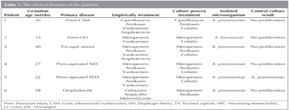LETTER TO THE EDITOR
Doi: 10.5578/tt.7846
Tuberk Toraks 2015;63(1):60-61

Ventilat?r ili?kili pn?moni tan?l? yenido?an bebeklerde endotrakeal aspirat k?lt?r?n?n de?eri
Kadir ?erafettin TEKG?ND?Z1, Mustafa KARA1, ?brahim CANER1, Ya?ar DEM?RELL?1
1 Atat?rk ?niversitesi T?p Fak?ltesi, ?ocuk Sa?l??? ve Hastal?klar? Anabilim Dal?, Neonatoloji Bilim Dal?, Erzurum, Turkey
1 Division of Neonatology, Department of Children's Health and Diseases, Faculty of Medicine, Ataturk University,
Erzurum, Turkey
We read the manuscript of G?rg?n et al. entitled ?The role of endotracheal aspiration in the diagnosis of ventilator associated pneumonia? with great interest (1). They reported 24 patients who received invasive mechanical ventilation (IMV) because of respiratory failure and died with the suspicion of ventilator associated pneumonia (VAP). Post-mortem lung biopsy was performed for 18 of them. They compared culture results of endotracheal aspirate performed with in 48 hours before death with microbiological and histopathological results of post-mortem lung biopsy specimens. They reported that 11/18 (61.1%) patients were diagnosed proven VAP and endotracheal aspirate cultures was positive in 9 (81.8%) of 11 patients. They suggested that endotracheal aspirate culture is useful in the diagnosis of VAP.
Nosocomial infections represent a major problem in neonatal intensive care units (NICUs) (2). Specially IMV is independent risk factor for nosocomial infection and the development of VAP (3). Broad-spectrum antibiotics have been commonly used since early diagnosis and treatment is crucial. However, this situation leads to an increase in multidrug resistant microorganisms (2). Although Centers for Diseases Control and Prevention (CDC) has standard definitions for nosocomial infection and VAP, microbiological evidence is needed for agent specific treatment (4). Quantitative cultures of endotracheal aspirate from mechanically ventilated newborn infants are frequently obtained in the evaluation of pneumonia, although they are not included in the diagnostic criteria for VAP (5). Few papers exist related to the use or interpretation of endotracheal aspirate in this special patient population (6). So we want to represent that endotracheal aspirate culture may also be used for isolating microorganisms in newborns with VAP. We obtained endotracheal aspirate culture from 6 patients between January 2012 and July 2013. Two (33.3%) patient were term, while 4 (66.7%) were premature. Median gestational age and birth weight was 34.5 weeks (27-40) and 2025 g (920-3200), respectively. Patients' clinical features and isolated microorganisms are presented in Table 1. Endotracheal aspirate culture was obtained on postnatal median 22th (13-55) days. The most common isolated microorganism was Klebsiella pneumoniae (5/6 patients), followed by Acinetobacter baumannii (1/6 patient). In all patients, the empirical antibiotics treatment was changed according to culture results (Table 1). Control cultures were collected on median 4.5th (4-5) days after treatment. Infection persisted in only 1 patient (16.7%). This patient died due to VAP. Remaining 5 patients whom control cultures were sterile on following, improved clinically and radiographically.
In conclusion, we suggest that endotracheal aspirate culture is needed for isolation of microorganism and adjustment of treatment in newborn with VAP. But it should be kept in mind that endotracheal aspirate culture alone is not sufficient to make the diagnosis. Because proliferation of microorganism can be a contamination. We believe that large prospective studies are needed to accurately define neonatal VAP and to develop effective preventive and therapeutic protocols in the future.
CONFLICT of INTEREST
None declared.
Geli? Tarihi/Received: 05.06.2014 • Kabul Edili? Tarihi/Accepted: 26.06.2014
REFERENCES
- G?rg?n A, Korkmaz Ekren P, Bacako?lu F, Ba?o?lu OK, Dirican N, Aydemir ? ve ark. Ventilat?rle ili?kili pn?moni tan?s?nda endotrakeal aspirat?n de?eri. Tuberk Toraks 2013;61(4):288-94.
- Celik IH, Demirel G, Tatar Aksoy H, Saygan S, Canpolat FE, Uras N, et al. Acinetobacter baumannii: an important pathogen with multidrug resistance in newborns. Mikrobiyol Bul 2011;45(4):716-22.
- Tan B, Zhang F, Zhang X, Huang YL, Gao YS, Liu X, et al. Risk factors for ventilator-associated pneumonia in the neonatal intensive care unit: a meta-analysis of observational studies. Eur J Pediatr 2014;173(4):427-34.
- Horan TC, Andrus M, Dudeck MA. CDC/NHSN surveillance definition of health care-associated infection and criteria for specific types of infections in the acute care setting. Am J Infect Control 2008;36:309-332.
- Baltimore SB. The difficulty of diagnosing ventilator-associated pneumonia. Pediatrics 2003;112:1420-1.
- Murila F, Francis JV, Bland A, Kumbla S, Doherty R, Sehgal A. Interpreting positive cultures of endotracheal aspirates: factors associated with treatment decisions in ventilated neonates. J Paediatr Child Health 2011;47(10):728-33.
Yaz??ma Adresi (Address for Correspondence)
Dr. Kadir ?erafettin Tekg?nd?z
Atat?rk ?niversitesi T?p Fak?ltesi,
?ocuk Sa?l??? ve Hastal?klar? Anabilim Dal?,
Neonatoloji Bilim Dal?,
ERZURUM - TURKEY
e-mail: kadirtek79@yahoo.com.tr

